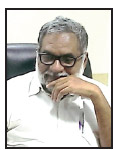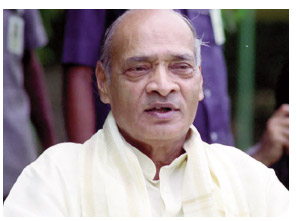Big-bang reforms
needed
 K R Sudhaman
K R Sudhaman
India had a share of
2.4 per cent in global
trade at the time of
independence. It
dropped to a mere
0.7 per cent in 1991.
The Narasimha Rao
era balance of
payment crisis forced
India to change its
economic
philosophy. And it
helped in opening up
of the economy and
India's two way trade.
 P.V. Narasimha Rao
India's two-way trade in goods
and services might have
reached $ 1 trillion, but
business as usual approach will
not help if we are to fully
recover from the slowdown
especially in merchandise exports.
P.V. Narasimha Rao
India's two-way trade in goods
and services might have
reached $ 1 trillion, but
business as usual approach will
not help if we are to fully
recover from the slowdown
especially in merchandise exports.
What we need is a big-bang reforms to
kick-start the export growth. Any delay
will cost us dearly.
Now global trade is picking up after
the world economy went into
recession due to 2008 economic crisis,
which is considered by many
economists to have been the worst
financial crisis since the Great
Depression of the 1930s. It began in
2007 with a crisis in the subprime
mortgage market in the United States,
and developed into a full-blown
international banking crisis with the
collapse of the investment bank
Lehman Brothers on September 15,
2008. It was followed by a global
economic downturn. Happily, that
phase is history today.
Global trade has started growing
rapidly at 4.7 per cent. According to
the International Monetary Fund, (IMF) global trade will grow
impressively at around 4.6 per cent in
the next couple of years. This has
thrown up yet another opportunity for
India. But the pick-up in India's exports
is not yet visible even though
merchandise has come out of the
negative territory.The government
really needs an out- of-the-box
thinking to put back merchandise and
services export back on high growth
pedestal.
Widening trade deficit to a 56-
month high at $16.3 billion in January
this year has certainly raised concerns
indicating all is not well in the trade
sector. India missed the bus in early
2000, when it had an opportunity to
become a global hub for
manufacturing. China, which pushed
reforms hard, was able to cash-in and
become a global manufacturing hub.
Globally, India's share in goods
exports is less than 2 per cent as
against China's nearly 14 per cent. But
in Services exports our performance is
slightly better at around 3.5 per cent of
world exports. Right policy and bigticket
reforms should be carried out speedily so that we do not waste yet
another opportunity that has come
our way.
India had a share of 2.4 per cent in
global trade at the time of
independence; it dropped to a mere
0.7 per cent in 1991 because of inward
looking policy of self-reliance, which
allowed only the surplus to be
exported. The Narasimha Rao era
balance of payment crisis forced India
to change its economic philosophy.
And it helped in opening up of the
economy and India's two way trade in both merchandise and services
zoomed to nearly $ one trillion
annually from a mere $70-80 billion in
1991. This is not enough. More needs
to be done to realise our true export
potential.
H A C Prasad, who until recently was
senior economic advisor in the finance
ministry, has come out with two
separate studies on the challenges and
policy initiatives needed to take India's
goods and services exports to a new
high. He holds the view that there are
green shoots in India's merchandise
exports that is goods exports. So it is
only appropriate to raise India's share
to a respectable five per cent. For this
India's goods exports should reach
$882 billion by 2022, which means
India's export growth rate must be
around 27 per cent CAGR in five years.
This is not an impossible feat
sinceIndia has had much higher
exports growth during 2004-09.
Services exports, which had gone up
from $53 billion in 2005 to $162 billion
annually in 2016, have done better
than goods exports in the first half of
2017-18 at 16.2 per cent. Various
initiatives have been taken by the
government to push services exports
but more needs to be done now
considering that ill-effects of
demonetization and rollout of Goods
and Services Tax (GST) are behind us.
Prasad's mantra for export nirvana
is simple. 'Make goods exports
demand based and not supply based
as at present', he says with some
justification. In his considered view,
there is also a need for 'Services from
India' initiative like the 'Make in India'
initiative to promote manufacturing
exports.
In most top imports of the World,
the presence of India is very small. In
2015, India's exports share in the top
100 items was not that impressive and
only in 5 of those items, the share was
more than 5 per cent. That's why there
is need for making our exports
demand based rather than supply
based.
Likewise there is need for
rationalizing tariffs. Though average
customs duty is around 10 per cent, the real applied duty is around 2.8 per
cent because various exemptions. This
is creating distortions. However, the
recent hike in customs duty on some
electronics items waswarranted to
promote Make in India. The move
helped in reversing inverted pyramid
customs duty structure that was
hindering domestic manufacturing.
On ease of doing business, India
has, no doubt, moved up in the global
rankings but it has many miles to go
before it can relax and rest. India is still
way behind many ASEAN countries in
trading across borders. Though the
government claims to have put in
place a single window customs
clearance for exporters, there are still
hurdles which needed to be crossed.
India is the cheapest and largest
manufacturer of agri products,
particularly fruits and vegetables, and
yet its share of global agri exports is
very small. It is one area where the
government has to come out with an
out of the box initiative so that India
becomes not only a major exporter
but also addresses the livelihood
concern of farmers. There is a need to
create an Ombudsman for resolving
export-related problems and disputes.
Presently there is no clear cut dispute
resolution mechanism.
On promoting services exports also,
there is a need to reform domestic
regulations so that these are
conducive for exports rather than
erecting restrictive trade barriers.
There are many market access trade
barriers in India's trading partner
countries; some of these relate to
visas, shipping, licensing of
professional services and so on. There
is tremendous potential for
disinvestment of PSUs - both central
and state, particularly in the hotels
sector.
When it comes to shipping, India
should strengthen its domestic
shipping industry including that of
public sector.
On its part, the government should
do two things. One, make shipments
cheaper through domestic liners. Two,
make it mandatory for domestic liners
to carry bulk imports as well as some
On ease of doing
business, India has, no
doubt, moved up in the
global rankings but it
has many miles to go
before it can relax and
rest India is still way
behind many ASEAN
countries in trading
across borders. Though
the government claims
to have put in place a
single window customs
clearance for exporters,
there are still hurdles
which needed to be
crossed.
of the exports. The Government must
quickly come to grips with another
issue – upgradation of port facilities
and connectivity. Even Colombo has a
major trans shipment port, which is far
superior to the best ports in India.
Another added urgency for big
bang exports is to end the present
negative job growth rate. Almost 45
per cent of India's exports come from
small and medium industries
(MSMEs). It is a well known fact that
small scale industries provide more
employment than large industries.
While Rs 1-1.5 lakh investment is
required in MSMEs for creating one
job, it is nearly 3-4 times more in large
industries, which are by nature capital
intensive. So boosting exports would
not only improve forex reserves but
also give a fillip to economic growth
besides ending jobless growth.
(K R Sudhaman, a senior
journalist, is a former Editor of
TickerNews and Financial
Chronicle)




 K R Sudhaman
K R Sudhaman P.V. Narasimha Rao
P.V. Narasimha Rao